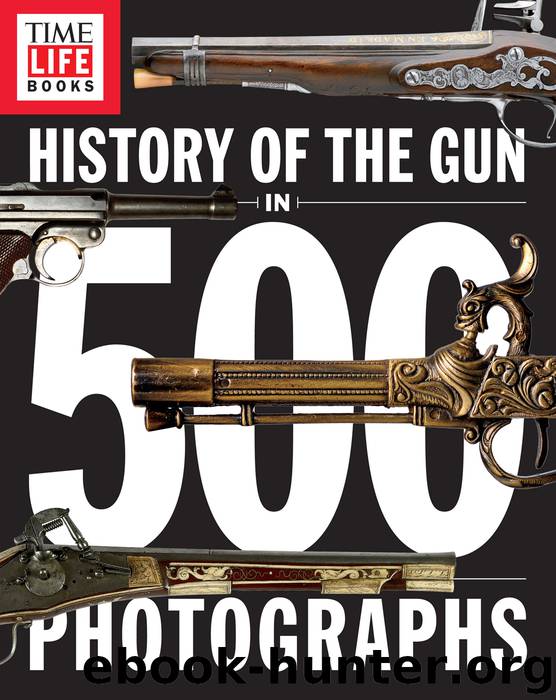History of the Gun in 500 Photographs by The Editors of TIME

Author:The Editors of TIME
Language: eng
Format: epub
Tags: HIS027080
Publisher: THEI
Published: 2016-05-09T16:00:00+00:00
Lieutenant Colonel George A. Custer and 262 7th Cavalry soldiers were outmanned and outgunned at the Battle of Little Bighorn in Montana in 1876.
The Little Bighorn Battlefield National Monument, with tributes to Native Americans and the 7th U.S. Cavalry.
SHARPS 1856 CARBINE
Country: United States
Date: 1856
Barrel Length: 17 9/10in
Caliber: .56
SPRINGFIELD MODEL 1873 “TRAPDOOR”RIFLE
Country: United States
Date: 1876
Barrel Length: 32 1/2in
Caliber: .45
SHARPS BIG 50 RIFLE
Country: United States
Date: 1872
Caliber: .50
Up to 60 million bison were killed in the latter half of the 19th century. Sharps .50-caliber rifles added to the carnage.
The now politically incorrect term “cowboys and Indians” typically conjures the Wild West era. But it was far more common in the late 19th century for units of the U.S. Army to confront Native Americans in battles for territory and dominance—and militarily, the Plains Indians outwitted, outplanned, and outmaneuvered the cavalrymen. At the 1876 Battle of Little Bighorn, for example, a combined force of Lakota, Cheyenne, and Arapaho warriors vanquished 700 men under the command of George Armstrong Custer. Five of the dozen companies of the 7th U.S. Cavalry were wiped out, with 263 Army soldiers killed, including Custer. About 40 to 50 Native Americans are thought to have died in the confrontation.
A number of factors contributed to the debacle known as Custer’s Last Stand. Custer ignored warnings from his scouts, his command was riven by internal rivalries, and most fatally, he divided his forces. The deployment of firearms also played a role.
Custer’s cavalry troops went into battle with breech-loading, single-shot Springfield Model 1873 carbines and .45 caliber Colt 1873 Single Action Army revolvers. Repeating rifles designed by Henry, Spencer, and Winchester were all available at the time, but the post–Civil War U.S. Army’s ordnance department stuck with a single-shot rifle as its standard, in part because the Springfield was relatively inexpensive to manufacture but also because they thought soldiers armed with single-shot weapons would be less likely to waste ammunition. Army officers were also following the lead of European militia, which generally avoided repeating weapons. Custer rejected an offer to add rapid-fire Gatling Guns to his arsenal, telling an Army colleague that bulky wheeled Gatling Guns would “hamper our movements.” The 7th Cavalry, a cocky Custer added, “can handle anything it meets.”
The several Indian groups came to the fight at Little Bighorn with an extraordinary array of weapons purchased and scavenged over time. Some of the Native Americans carried traditional bow and arrow, and when the dust settled, a number of Army dead resembled human pincushions. But the Native American warriors did far more damage with firearms. Hundreds of the mounted tribe members carried rifles and revolvers, including Henrys, Sharps, Winchesters, Remingtons, Smith & Wessons, and even British Enfields (the latter originally imported by the Confederate Army during the Civil War).
Historical accounts include the recollection of a Cheyenne warrior named Wooden Leg, who was armed with what he said was a “six shooter,” probably a Colt revolver. White Cow Bull, an Oglala Lakota warrior, claimed to have a repeating rifle. All told, historians have found evidence of 62 Indian-owned .
Download
This site does not store any files on its server. We only index and link to content provided by other sites. Please contact the content providers to delete copyright contents if any and email us, we'll remove relevant links or contents immediately.
| Ammo & Grenades | Firearms |
| Swords & Knives |
How to Be a Bawse: A Guide to Conquering Life by Lilly Singh(7393)
Spare by Prince Harry The Duke of Sussex(5072)
Millionaire: The Philanderer, Gambler, and Duelist Who Invented Modern Finance by Janet Gleeson(4376)
Machine Learning at Scale with H2O by Gregory Keys | David Whiting(4182)
Never by Ken Follett(3791)
Harry Potter 02 & The Chamber Of Secrets (Illustrated) by J.K. Rowling(3622)
The Heroin Diaries by Nikki Sixx(3494)
Urban Outlaw by Magnus Walker(3342)
Harry Potter and the Prisoner of Azkaban (Book 3) by J. K. Rowling(3304)
Fairy Tale by Stephen King(3220)
Japanese Design by Patricia J. Graham(3110)
The Man Who Died Twice by Richard Osman(2997)
The Club by A.L. Brooks(2862)
Stacked Decks by The Rotenberg Collection(2812)
Will by Will Smith(2793)
Harry Potter and the Deathly Hallows (7) by J.K. Rowling(2641)
Churchill by Paul Johnson(2506)
The Chimp Paradox by Peters Dr Steve(2298)
Borders by unknow(2229)
